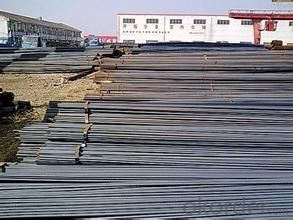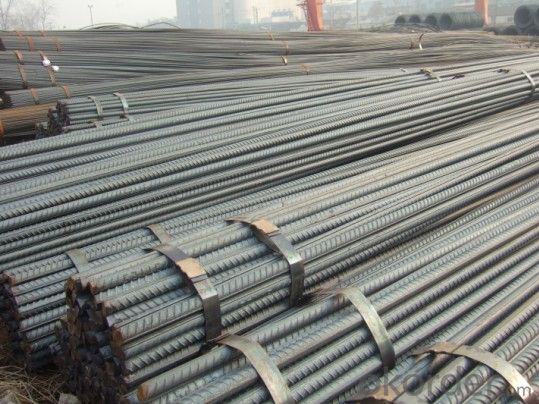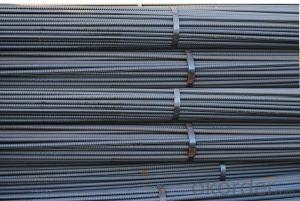Hot rolled deformed steel bar bar for construction
- Loading Port:
- Tianjin
- Payment Terms:
- TT OR LC
- Min Order Qty:
- 10000 m.t.
- Supply Capability:
- 100000 m.t./month
OKorder Service Pledge
OKorder Financial Service
You Might Also Like
Item specifice
OKorder is offering high quality GR40 deformed steel bar bar for construction at great prices with worldwide shipping. Our supplier is a world-class manufacturer of steel, with our products utilized the world over. OKorder annually supplies products to European, North American and Asian markets. We provide quotations within 24 hours of receiving an inquiry and guarantee competitive prices.
Product Applications:
GR40 deformed steel bar bar for construction for construction for construction are ideal for structural applications and are widely used in the construction of buildings and bridges, and the manufacturing, petrochemical, and transportation industries.
Product Advantages:
OKorder's deformed steel bar are durable, strong, and resist corrosion.
Main Product Features:
· Premium quality
· Prompt delivery & seaworthy packing (30 days after receiving deposit)



· Corrosion resistance
· Can be recycled and reused
· Mill test certification
· Professional Service
· Competitive pricing
Specifications of Deformed Steel Bar ASTM A615 GR40 GR60 with High Quality:
Standard | GB | HRB335, HRB400, HRB500 | |
UK | G460B, B500A, B500B,B500C | ||
USA | GR40, GR60 | ||
Diameter | 6mm,8mm,10mm,12mm,14mm,16mm,18mm,20mm, 22mm,25mm,28mm,32mm,36mm,40mm,50mm | ||
Length | 6M, 9M,12M or as required | ||
Place of origin | Hebei, China mainland | ||
Application | building,construction,road,bridge etc | ||
Brand name | DRAGON | ||
Theoretical weight and section area of each diameter as below for your information:
Diameter(mm) | Section area (mm²) | Mass(kg/m) |
6 | 28.27 | 0.222 |
8 | 50.27 | 0.395 |
10 | 78.54 | 0.617 |
12 | 113.1 | 0.888 |
14 | 153.9 | 1.21 |
16 | 201.1 | 1.58 |
18 | 254.5 | 2.00 |
20 | 314.2 | 2.47 |
22 | 380.1 | 2.98 |
25 | 490.9 | 3.85 |
28 | 615.8 | 4.83 |
32 | 804.2 | 6.31 |
36 | 1018 | 7.99 |
40 | 1257 | 9.87 |
50 | 1964 | 15.42 |
Usage and Applications of Deformed Steel Bar ASTM A615 GR40 GR60 with High Quality:
Deformed bar is widely used in buildings, bridges, roads and other engineering construction. Big to highways, railways, bridges, culverts, tunnels, public facilities such as flood control, dam, small to housing construction, beam, column, wall and the foundation of the plate, deformed bar is an integral structure material. With the development of world economy and the vigorous development of infrastructure construction, real estate, the demand for deformed bar will be larger and larger..
Deformed bar is widely used in buildings, bridges, roads and other engineering construction. Big to highways, railways, bridges, culverts, tunnels, public facilities such as flood control, dam, small to housing construction, beam, column, wall and the foundation of the plate, deformed bar is an integral structure material. With the development of world economy and the vigorous development of infrastructure construction, real estate, the demand for deformed bar will be larger and larger..
Packaging & Delivery of HRB400 Deformed Steel Bar:
Packaging Detail: products are packed in bundle and then shipped by container or bulk vessel, deformed bar is usually naked strapping delivery, when storing, please pay attention to moisture proof. The performance of rust will produce adverse effect.
Each bundle weight: 2-3MT, or as required
Payment term: TT or L/C
Delivery Detail: within 45 days after received advanced payment or LC.
Label: to be specified by customer, generally, each bundle has 1-2 labels
Trade terms: FOB, CFR, CIF
FAQ:
Q1: Why buy Materials & Equipment from OKorder.com?
A1: All products offered byOKorder.com are carefully selected from China's most reliable manufacturing enterprises. Through its ISO certifications, OKorder.com adheres to the highest standards and a commitment to supply chain safety and customer satisfaction.
Q2: What makes stainless steel stainless?
A2: Stainless steel must contain at least 10.5 % chromium. It is this element that reacts with the oxygen in the air to form a complex chrome-oxide surface layer that is invisible but strong enough to prevent further oxygen from "staining" (rusting) the surface. Higher levels of chromium and the addition of other alloying elements such as nickel and molybdenum enhance this surface layer and improve the corrosion resistance of the stainless material.
- Q:How are steel rebars protected against chemical attacks?
- Steel rebars are typically protected against chemical attacks through the use of protective coatings or by incorporating corrosion inhibitors in the concrete mix. These measures act as barriers, preventing corrosive elements from reaching and damaging the steel rebars.
- Q:Are steel rebars affected by magnetic fields?
- Yes, steel rebars are affected by magnetic fields. Since steel is a ferromagnetic material, it can be magnetized and influenced by external magnetic fields.
- Q:Can steel rebars be used in the construction of stadiums and arenas?
- Yes, steel rebars can be used in the construction of stadiums and arenas. Steel rebars provide strength and durability to concrete structures, making them ideal for large-scale projects like stadiums and arenas that require high load-bearing capacity and structural integrity.
- Q:Can steel rebars be used in structures with high radiation shielding requirements?
- Steel rebars can indeed be used in structures with high radiation shielding requirements. Steel is known for its excellent strength and durability, making it a popular choice for reinforcing concrete structures. When it comes to radiation shielding, steel rebars can effectively provide a certain level of protection due to their dense composition. While steel itself is not a highly effective radiation shield compared to materials like lead or concrete, it can still contribute to reducing the transmission of radiation. The dense nature of steel helps to scatter and absorb some of the radiation passing through the structure, thereby reducing the overall exposure. However, it's important to note that for structures with extremely high radiation shielding requirements, additional measures may be necessary. These could include incorporating other radiation-absorbing materials like lead or concrete, or implementing specific design features to enhance the shielding capabilities of the structure. Ultimately, the choice of materials and design considerations should be made in consultation with radiation safety experts and engineers who can assess the specific shielding requirements and recommend the most appropriate solutions.
- Q:What is the process of cutting and bending steel rebars on-site?
- The process of cutting and bending steel rebars on-site typically involves the use of specialized tools such as rebar cutters and benders. First, the required length of rebar is measured and marked. Then, the rebar cutter is used to accurately cut the rebar to the desired length. Next, if any bends or shapes are required, the rebar is placed in the bending machine, which applies pressure to bend it accordingly. This process ensures that the steel rebars are tailored to fit the specific construction needs on-site.
- Q:How are steel rebars protected against damage during the construction process?
- Steel rebars are protected against damage during the construction process through various methods including proper storage, careful handling, and implementing measures such as covering them with protective coatings or using plastic caps. Additionally, rebars are often placed strategically within concrete structures to minimize exposure and vulnerability to potential damage.
- Q:Can steel rebars be used in energy-efficient buildings?
- Certainly! Energy-efficient buildings can indeed incorporate steel rebars. These rebars are commonly utilized in the construction of reinforced concrete structures, including those that prioritize energy efficiency. Energy-efficient buildings aim to decrease energy consumption and minimize their environmental footprint. Although steel is a material with high embodied energy, meaning it requires a substantial amount of energy for production, it boasts numerous advantages for energy-efficient buildings. To begin with, steel rebars lend structural strength to reinforced concrete, enabling the creation of robust and long-lasting structures. This is pivotal for energy-efficient buildings, as their goal is to have an extended lifespan and reduced maintenance requirements, thereby lessening their overall environmental impact. Additionally, steel rebars can be employed in the construction of energy-efficient building components, such as insulated concrete forms (ICFs) and precast concrete panels. These building systems possess exceptional thermal insulation properties, which decrease heat transfer and enhance energy efficiency. Steel rebars are utilized to reinforce these components, ensuring their structural integrity. Furthermore, the thermal mass characteristics of concrete, reinforced by steel rebars, can contribute to a building's energy efficiency. Concrete has the capability to absorb and store heat, aiding in the regulation of indoor temperatures and reducing the need for excessive heating or cooling. Consequently, this can result in significant energy savings throughout a building's lifespan. It is important to note that the energy efficiency of a building is contingent upon various factors, including insulation, window design, HVAC systems, and the integration of renewable energy. While steel rebars play a vital role in reinforced concrete structures, their impact on overall energy efficiency should be evaluated in conjunction with other design choices and building materials.
- Q:Can steel rebars be used in dam construction projects?
- Certainly, steel rebars can be utilized in dam construction projects without a doubt. In the construction industry, steel rebars are commonly employed for reinforcing concrete structures, and dams are no exception to this rule. To enhance the tensile strength of concrete, the rebars are embedded within it, thereby rendering it more resistant to cracking and structural failure. Dams, being colossal structures engineered to withhold water, necessitate a high level of strength and durability to withstand the tremendous forces and pressures exerted by the water. By providing the required reinforcement, steel rebars ensure the dam's structural integrity. Moreover, steel rebars possess corrosion-resistant properties, which are of utmost significance in dam construction, where constant exposure to water occurs. All in all, the utilization of steel rebars in dam construction projects is a well-established and vital practice.
- Q:What are the guidelines for the proper storage of steel rebars on construction sites?
- Proper storage of steel rebars is crucial on construction sites to ensure their integrity and prevent any potential hazards. Here are some guidelines for the correct storage of steel rebars: 1. Select a suitable storage area: Choose a flat, stable, and well-drained area for storing steel rebars. Avoid locations prone to flooding or excessive moisture. 2. Provide adequate space: Allow enough space between rebars to prevent any contact or entanglement that may cause damage. Maintain clear aisles and paths for easy access and movement. 3. Protect against corrosion: Steel rebars should be protected from moisture and corrosion. Cover them with waterproof and UV-resistant tarpaulins or plastic sheets to shield them from rain, snow, or direct sunlight. 4. Elevate from the ground: Place the rebars on wooden supports or pallets to keep them off the ground. This prevents contact with water, dirt, or any other contaminants that could accelerate corrosion. 5. Securely stack rebars: Stack the rebars horizontally in a way that ensures stability and prevents them from rolling or falling. Place larger and heavier rebars at the bottom of the stack to provide a secure base. 6. Label and organize: Clearly label each stack with information such as size, length, and grade for easy identification. Organize the storage area by separating different sizes or types of rebars to minimize confusion and facilitate retrieval. 7. Regularly inspect and maintain: Conduct routine inspections to check for any signs of corrosion, damage, or deformation. Remove any rebars that show signs of deterioration to prevent accidents or compromised structural integrity. 8. Handle with care: When moving or transporting rebars, use appropriate lifting equipment like cranes, forklifts, or hoists. Avoid dragging or dropping them, as this can cause deformation or damage. 9. Follow manufacturer's recommendations: Consult the manufacturer's guidelines for specific storage requirements and recommended practices for the particular type of steel rebars being used. By following these guidelines, construction sites can ensure the proper storage of steel rebars, which in turn helps maintain their quality, prolong their lifespan, and guarantee the safety of workers and structures.
- Q:How are steel rebars different from other types of reinforcement?
- Steel rebars are different from other types of reinforcement primarily because they are made of steel, which gives them high tensile strength and durability. Unlike other materials like wood or concrete, steel rebars can withstand heavy loads and provide structural integrity to reinforced concrete structures. Additionally, steel rebars can be easily molded and shaped into various designs, making them versatile and suitable for different construction applications.
1. Manufacturer Overview |
|
|---|---|
| Location | |
| Year Established | |
| Annual Output Value | |
| Main Markets | |
| Company Certifications | |
2. Manufacturer Certificates |
|
|---|---|
| a) Certification Name | |
| Range | |
| Reference | |
| Validity Period | |
3. Manufacturer Capability |
|
|---|---|
| a)Trade Capacity | |
| Nearest Port | |
| Export Percentage | |
| No.of Employees in Trade Department | |
| Language Spoken: | |
| b)Factory Information | |
| Factory Size: | |
| No. of Production Lines | |
| Contract Manufacturing | |
| Product Price Range | |
Send your message to us
Hot rolled deformed steel bar bar for construction
- Loading Port:
- Tianjin
- Payment Terms:
- TT OR LC
- Min Order Qty:
- 10000 m.t.
- Supply Capability:
- 100000 m.t./month
OKorder Service Pledge
OKorder Financial Service
Similar products
New products
Hot products
Related keywords





























